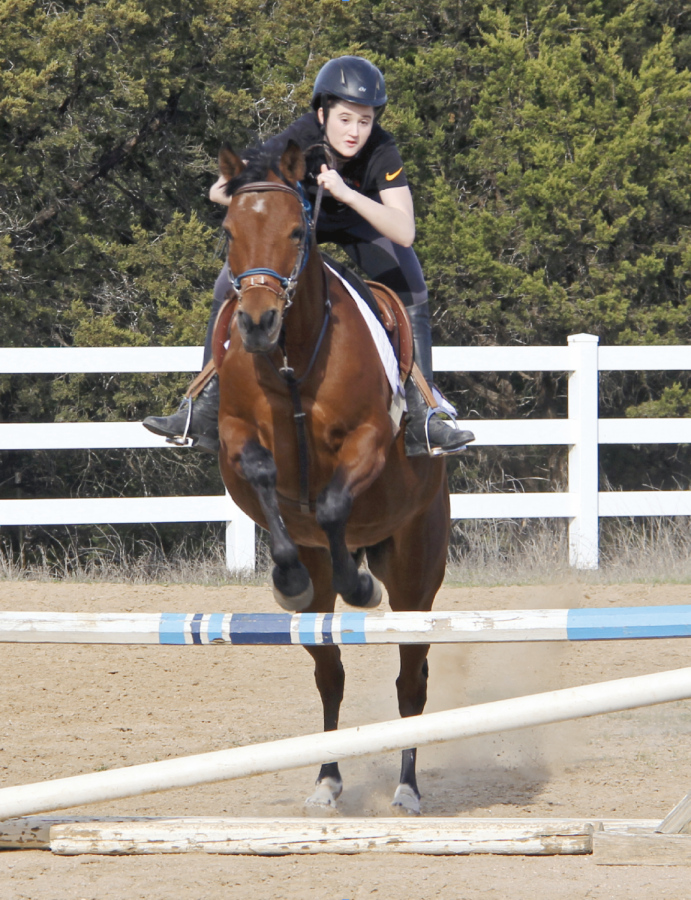Equestrian jumps to new heights
JUMP FOR JOY: Juliane Payne practices jumps with her horse, Bee, at practice. She began riding horses in elementary school and now rides at Creekwood Stables.
February 20, 2020
She gracefully bounces up and down while trotting through the course before flying through the air in the perfect position to help her horse jump as high as it possibly can. Junior equestrian Juliane Payne and her beloved horse, Bee, clear the jump by a mile to win the approval of the crowd as applause fills the air.
Payne rode horses when she was very young, but she picked it up again in middle school after taking a break from it for a couple years.
“I rode Western for a couple years in elementary school,” Payne said. “A friend of mine got me into Jumpers in middle school, and I’ve been doing it since.”
Between school and being a member of the JV basketball team, Payne has to dedicate a lot of time to caring for her horse.
“I usually see her two to three times a week during the school year and nearly every day in the summer,” Payne said. “Most of the upkeep for the horses is done by the owner of the stables, but I keep my horse groomed and keep her tack/equipment clean.”
Laurel Heiden, Payne’s trainer at Creekwood Stables, has been around horses since she was a young girl and knows how big of a responsibility it is to own a horse.
“Daily care and upkeep of the horses would be the most obvious [duties],” Heiden said. “Keeping the riders safe has always been my top priority, and that means different things in different situations. Also, keeping the horses happy is very important.”
Payne rides competitively and specializes in jumper shows.
“[Competing is] an all-day event and often lasts multiple days,” Payne said. “One rider goes into the ring at a time and completes a course of jumps. You are scored based on your time, but if you knock over a jump or go off-course, you are automatically disqualified.”
Junior Ella Roddenberry has attended some of Payne’s competitions and practices.
“I’ve got to see Juliane ride her horse multiple times,” Roddenberry said. “At competition, I got to see Juliane feed her horse, put all her gear on her horse to get it ready for the competition, [and] then [warm] up on her horse in the practice area.”
To prepare for competition, Payne practices a lot and focuses on establishing a good relationship with her horse.
“To be successful at horseback riding, you need to be physically fit, but what’s really important is that you can’t hesitate and [must] make decisions quickly,” Payne said. “You have to make decisions for both you and your horse.”
A typical practice involves a trainer and a small group of riders going out to work on jumps.
“During lessons, me and a few other riders are in a group and take turns jumping mini courses our trainer sets up for us,” Payne said. “Sometimes we jump multiple jumps in a row, and sometimes we push for height.”
Payne usually performs fairly well with Bee and often places high at competitions.
“[Bee] has a really big heart but an equally big ego,” Heiden said. “Jules has the ability to convince Bee to do what she wants while making Bee believe that it is all her idea. Her ability to connect and communicate with Bee is really beautiful to watch.”
Roddenberry was surprised by how fun horseback riding was to watch and loved seeing Payne work with her horse in competition.
“I was impressed by Juliane’s horseback riding skills and how she could control her horse and get it to [perform so well],” Roddenberry said.
Heiden notes how one of the more difficult aspects of horseback riding is that they are wild animals, so riders must communicate with them at all times.
“I think that the most challenging part for riders is being able to leave your emotions behind when you get on the horse,” Heiden said. “If you’ve had a bad day, you can’t take that into the saddle with you. Learning how to leave all of that behind when you climb into the saddle is a hard lesson.”
Payne recommends horseback riding to others because it can be very rewarding.
“The most rewarding part is [either] when you complete a jump really well and it feels like you’re flying, or the really strong connection I made with my horse,” Payne said. “She is a really talented horse, and I trust her not to put me in harm’s way.”
As a trainer, Heiden enjoys seeing her riders succeed and push themselves.
“When a rider comes off of a jump that they were maybe a bit nervous about doing or that you knew would challenge them and they have a giant smile on their face…that’s the best,” Heiden said.
Both Payne and Heiden’s lives have been positively impacted by horseback riding.
“Obviously riding is great exercise, but beyond that, horses are amazing creatures,” Heiden said. “They have the ability to look deep inside of a person and see the real you. Connecting with an animal and being able to communicate with them through body language is really exhilarating.”











